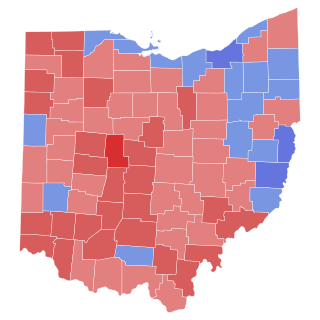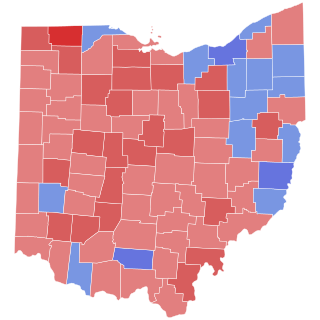| |||||||||||||||||
| |||||||||||||||||
| |||||||||||||||||
The 1934 United States Senate election in Ohio took place on November 6, 1934. Incumbent Republican Senator Simeon Fess ran for a third term in office, but was defeated by Democratic former Governor of Ohio Vic Donahey in a landslide.
| |||||||||||||||||
| |||||||||||||||||
| |||||||||||||||||
| Elections in Ohio |
|---|
 |
The 1934 United States Senate election in Ohio took place on November 6, 1934. Incumbent Republican Senator Simeon Fess ran for a third term in office, but was defeated by Democratic former Governor of Ohio Vic Donahey in a landslide.
| Party | Candidate | Votes | % | |
|---|---|---|---|---|
| Democratic | A. Victor Donahey | 263,398 | 43.94% | |
| Democratic | Charles F. West | 168,120 | 28.05% | |
| Democratic | George White | 167,939 | 28.02% | |
| Total votes | 599,457 | 100.00% | ||
| Party | Candidate | Votes | % | ±% | |
|---|---|---|---|---|---|
| Democratic | A. Victor Donahey | 1,276,206 | 59.95% | ||
| Republican | Simeon Fess (incumbent) | 839,068 | 39.41% | ||
| Communist | William C. Sandberg | 13,546 | 0.64% | ||
| Write-in | 23 | 0.00% | N/A | ||
| Total votes | 2,128,820 | 100.00% | |||
| Democratic gain from Republican | |||||

Alvin Victor "Honest Vic" Donahey was an American Democratic Party politician from Ohio. Donahey was the 50th governor of Ohio and a United States Senator from Ohio.

The 1916 United States Senate elections were elections that coincided with the re-election of President Woodrow Wilson. This was the first election since the enactment of the Seventeenth Amendment that all 32 Class 1 senators were selected by direct or popular elections instead of state legislatures. Republicans gained a net of two seats from the Democrats, and then a furthered seat through mid-term vacancies thereby reducing Democrats to a 53-43 majority.

The 1974 United States Senate election in Ohio took place on November 5, 1974. It was concurrent with elections to the United States House of Representatives. Incumbent Democratic U.S Senator Howard Metzenbaum was running for election his first full term after he was appointed in 1974 by Ohio governor John J. Gilligan to fill out the Senate term of William B. Saxbe, who had resigned to become United States Attorney General. Metzenbaum lost the primary election to John Glenn, who went on to win the general election and win every county in the state. Metzenbaum would later be elected in the other U.S. Senate seat in 1976 and worked with Glenn until he retired from the post in 1994.

The 1932 United States Senate election in Ohio took place on November 8, 1932. Incumbent Senator Robert J. Bulkley, who was elected to complete the unexpired term of Frank Willis, was elected to a full term in office. This would be the last time that Democrats would win Ohio Class 3 Senate seat until Frank Lausche did so in 1956.

The 1920 United States Senate special election in Ohio was held on November 2, 1920. Incumbent Republican Senator Warren G. Harding did not run for re-election, opting instead to run for President of the United States. Republican Governor Frank B. Willis defeated William Alexander Julian in the race for the open seat.

The 1922 United States Senate election in Ohio took place on November 7, 1922. Incumbent Democratic Senator Atlee Pomerene ran for re-election to a third term in office, but was defeated by Republican U.S. Representative Simeon Fess.

The 1952 United States Senate election in Ohio was held on November 4, 1952.

The 1946 United States Senate elections in Ohio was held on November 5, 1946, alongside a concurrent special election to the same seat.

The 1940 United States Senate election in Ohio took place on November 5, 1940. Incumbent Democratic Senator Vic Donahey did not run for re-election to a second term. In the open race to succeed him, Republican Mayor of Cleveland Harold Hitz Burton defeated Democratic U.S. Representative John McSweeney.

The 1928 United States Senate election in Ohio took place on November 6, 1928. Incumbent Republican Senator Simeon Fess was re-elected to a second term in office over Democratic Director of Agriculture Charles Truax.

The 1970 United States Senate election in Ohio took place on November 3, 1970. Incumbent Democratic Senator Stephen M. Young did not run for re-election to a third term in office. U.S. Representative Robert Taft Jr. won the open seat over Democrat Howard Metzenbaum.

The 1968 United States Senate election in Ohio took place on November 5, 1968. Incumbent Senator Frank Lausche ran for re-election to a third term, but lost the Democratic primary to former U.S. Representative John J. Gilligan. Before losing the primary to the more solidly liberal Gilligan, Lausche had one of the most conservative voting record among Senate Democrats, leaving the Democratic Party very disappointed. In the general election, Gilligan lost to Republican Ohio Attorney General William Saxbe in a close race. Saxbe's victory increased the number of Senate Republicans in the 91st Congress. He would serve 5 years in the Senate before being nominated by President Richard Nixon to be U.S Attorney General, he resigned the seat after being confirmed. Gilligan, who in January 1974 was serving as the Governor of Ohio, named Saxbe's successor.

The 1962 United States Senate election in Ohio took place on November 6, 1962. Incumbent Senator Frank Lausche was re-elected to a second term in office, easily defeating Republican attorney John Marshall Briley.

The 1956 United States Senate election in Ohio took place on November 6, 1956. Incumbent Senator George H. Bender, who won a special election to complete the term of the late Senator Robert A. Taft, ran for re-election to a full six-year term. He was defeated by Democratic Governor Frank Lausche. As of 2023, this is the last time that an incumbent Senator from Ohio lost re-election for this seat.

The 1944 United States Senate election in Ohio took place on November 7, 1944. Incumbent Republican Senator Robert A. Taft, first elected in the Republican wave of 1938, was narrowly elected to a second term in office over Democratic former Lieutenant Governor William G. Pickrel, winning 71 of Ohio's 88 counties. Despite Pickrel winning the state's largest urban centers such as Cleveland, his margins there were overcome by Taft's strong showings in the rural areas and small towns. Nevertheless, at less than a point, Taft's victory was significantly smaller than his 7 point win in 1938.

The 1938 United States Senate election in Ohio took place on November 7, 1938. Incumbent Senator Robert J. Bulkley ran for re-election to a second full term in office, but was defeated by the Republican nominee, former state Senator Robert A. Taft, the elder son of former President and supreme court chief justice William Howard Taft. Taft's victory was a part of a major Republican wave nationally, where Republicans gained 8 Senate seats and 81 seats in the House of Representatives, which was largely attributable to incumbent Democratic President Franklin Roosevelts's unpopularity in the aftermath of the Recession of 1937–1938 and the President's controversial plan to add more seats to the Supreme Court, which he proposed after the court ruled some of his New Deal programs unconstitutional. Taft's victory marked the beginning of 4 consecutive Republican victories in this seat, and Democrats would not win it again until Governor Frank Lausche won it in 1956.

The 1928 United States Senate special election in Ohio was held on November 6, 1928 to elect a successor to Frank B. Willis, who died in office in March 1928. Republican U.S. Representative Theodore E. Burton, who previously held this seat from 1909 to 1915, won the open race to succeed him.

The United States Senate special election in Ohio of 1954 was held on November 2, 1954 to complete the unexpired term of late Senator Robert A. Taft, who died in office on July 31, 1953. Interim Senator Thomas A. Burke ran to complete the term in office but was narrowly defeated by U.S. Representative George Bender.

The 1916 United States Senate election in Ohio took place on November 7, 1916. Incumbent Democratic Senator Atlee Pomerene was re-elected to a second term in office over Republican former Governor and Ambassador to France Myron Herrick.

The 1964 United States Senate election in Ohio took place on November 3, 1964. Incumbent Democratic Senator Stephen M. Young was re-elected to a second term in office, narrowly defeating Republican U.S. Representative Robert Taft, Jr.